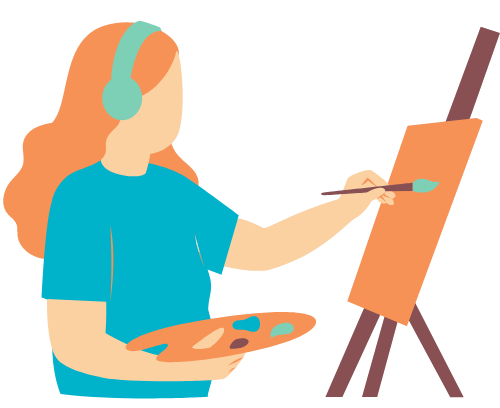Look at this incredible painting and the beautiful woman represented. At first look, it’s hard to understand who she is and we may mistakenly think she was just a model posing for Manet as many others had done before and after her. Well, not many know her or give her the credit she deserves, but the woman on the left is actually Berthe Morisot, a female painter.
Impressionism
She took part in one of my favorite movements of all time: impressionism, which developed in France’s second half of the nineteenth century. Impressionists shared the same interest in light and love for en Plein air painting and nature. As you can see in “Dans les blés” Berthe Morisot was a perfect representative of the French movement.

Without any doubt, its founder and most prominent figure is Monet, an incredible artist whose painting “Impression, Sunrise” which was shown in the first impressionist show, was the inspiration for the name of the whole group. Most people are fairly familiar with artists like Renoir, Monet and Degas and do not even now about the existence of Morisot’s artworks.
Life of Berthe Morisot
She came from a wealthy family who supported her in her artistic journey and pursuit at a time when women weren’t even allowed to go to the Academie of Beaux Arts yet. She studied under the guidance of the romantic painter Guichard and later on under Jean- Baptiste Camille Corot who will be her final mentor. From him, Berthe Morisot will learn to love en plein air painting and how to capture light naturally in her works. Unfortunately at the me may disapproved not only the thought of a woman working as a painter, but also of a woman painting outside so she encountered many difficulties in her journey as an artist.
Her encounter with Manet
Morisot habitually went to the Louvre to study some of her favorite paintings like the works of Rubens. During one of these visits, she met the painter Eduard Manet and immediately feels drawn to him (the feeling was mutual). Unfortunately for the love birds, Manet was married and so the two didn’t have the chance to develop their love story fully. The two, however, became inseparable and Manet made her his muse and model for many paintings. You have previously seen the balcony but now you can look at other portraits he has painted of her.
Her marriage and her daughter Julie
He introduced her to a circle of artists and intellectuals who would later, in 1873, become the impressionist movement. Despite how romantic a love story between the painter and his muse would have been Edouard was married and surprisingly she ended up marrying his brother, Eugene. The two made their home a gathering spot for artists and intellectuals alike (one of the most famous names is the writer Emile Zola).
Morisot really took seriously her role as a mother and loved dearly her daughter Julie. This love transpires in the many paintings she has done of the young girl. Even Renoir painted the two together showing the deep bond the two had with each other.
How she revolutionized Impressionism
With other impressionists, we are used to seeing beautiful landscapes or parties seen from afar where everyone is hiding behind the mask of a smile nd none of their individuality really shows through. Morisot added this new aspect in her works painting several portraits and domestic scenes in her home.
A Summer-day and her exploration of human emotions
In her paintings, Morisot explored human emotions with a mastery rarely seen before in impressionism. She was able to capture the raw emotions of her subjects, imbuing them with a unique life and vibrancy that could be felt by the viewer. Her masterpiece, ‘A Summer’s Day’ is a perfect example of this. In it, she captures the tranquil beauty of the scene, the gentle glimmer of the sun reflected off the river, and the subtle emotions of the figures on the boat, depicting a snapshot of a moment in time that is both tranquil and alive. Her use of color, light, and emotion in this painting is truly something to behold, showcasing her talent and skill as an artist.
Last year during a visit to the National Gallery I stumbled into a Summer-day. Honestly, I stood d there just looking at the painting for a while. It had a freshness that drew my curiosity in and I needed to learn more about the artwork and the artist behind it. I was pleasantly surprised when I discovered Berthe Morisot and I became really fascinated with her gentle way of painting people.
In addition to painting scenes of her everyday life, Morisot also explored her own emotions in her work. She often painted scenes of her daughter, Julia, or of herself alone in her home, depicting her own joy, sorrow, and longing with a deep emotional resonance. Her works give viewers a glimpse into her inner world, allowing them to connect with her in a profound way.
Conclusion
Morisot was a revolutionary artist, not only because of her gender but because of the emotional depth she was able to bring to her work. Her love of painting and the outdoors was undeniable, and her works continue to inspire generations of viewers to this day. Her breathtaking paintings provide an insight into the beauty and complexity of human emotions, allowing us to explore our own feelings in a way that words alone cannot.
Take a closer look at the paintings










Wanna learn more?
Just head over to my other articles and dive into the art world with me.
And don’t forget to check out my instagram profile and my twitter account to keep up with the most recent posts and interact with me.













